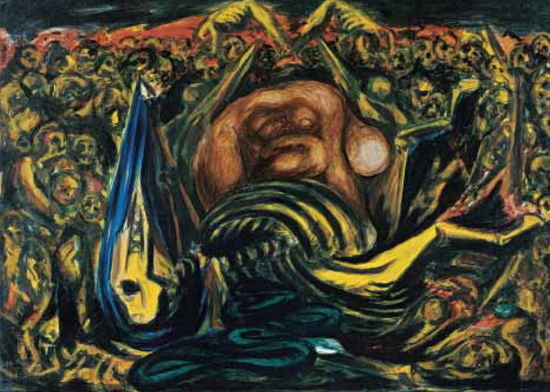Translating Revolution Gives Voice to American Muralists
By Laura M. Browning in Arts & Entertainment on Apr 26, 2010 7:00PM

Jackson Pollack, Untitled (Bald Woman with Skeleton) 1938-41, Collection of Hood Museum of Art, Dartmouth College, Hanover, NH. Purchased through the Miriam and Sidney Stoneman Acquisitions Fund © 2010 The Pollack-Krasner Foundation / Artists Rights Society (ARS), New York from the National Museum of Mexican Art's website
Nothing is lost in translation at the National Museum of Mexican Art’s Translating Revolution: U.S. Artists Interpret Mexican Muralists. One of the loveliest exhibits we’ve seen in a while, Translating Revolution showcases American artists who were influenced by Mexican muralists. Through the Works Progress Administration program, many American artists went to Mexico in the 1930s and 40s to learn from mural masters like los tres grandes, Diego Rivera, José Clemente Orozco, and David Alfaro Siqueiros. The subsequent paintings often reveal Marxist revolutionary underpinnings that give voice to the working class, strong lines and colors typical of the Mexican mural masters, and a surprising number of Chicago connections. Several artists in the exhibit studied at the Art Institute, and others, like Charles White (who was involved with the founding of the South Side Community Arts Center), were deeply ingrained in Chicago’s cultural past.
One of the exhibit’s most stunning pieces is a 1936 cartoon (a preparatory drawing) for a mural by Edward Millman called Contribution of Women to the Progress of Mankind, which was painted in Chicago’s former Lucy Flower High School. It was later painted over due to poor condition and parental complaints that high schoolers shouldn’t be exposed to such leftist thought or the horrors of war that Millman depicted.
We were pleased to see that Translating Revolution celebrates many women artists of the 1930s and 40s. It also adds a new dimension to well-known American artists like Edward Weston and Jackson Pollack, and the exhibit is so visually strong that Pollack’s Mexican influences are evident even to the untrained eye, something we think makes Translating Revolution a crowd-pleaser.
The mural movement, which was reinvented by the WPA during the Great Depression and again by Chicago’s community organizers in the 1970s, forms a significant element of our city’s visual culture. Don’t miss your chance to see la crema y nata.
Translating Revolution is showing at the National Museum of Mexican Art, 1852 West 19th Street, until August 1. Admission is free. All labels in the exhibit are in both English and Spanish.